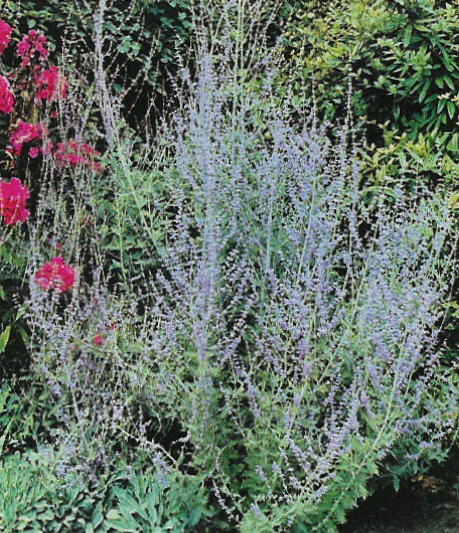| Botanical Name: Perovskia 'Blue Spire' | |
| Common Name: Blue Spire Russian Sage |

-
Anatomy
-
Culture
-
Design
Plant Type
Shrub, Perennial
Height Range
3-6'
Flower Color
Blue, Violet
Flower Season
Summer
Leaf Color
Grey Green, Grey
Bark Color
Brown, White
Fruit Color
n/a
Fruit Season
n/a
Sun
Full
Water
Low, Medium
Growth Rate
Moderate
Soil Type
Sandy, Clay, Loam, Rocky, Unparticular
Soil Condition
Average, Rich, Poor, Well-drained, Dry
Soil pH
Neutral, Basic
Adverse Factors
Attracts Bees, Invasive
Design Styles
English Cottage, Mediterranean, Ranch, Spanish
Accenting Features
Fragrance, Showy Flowers
Seasonal Interest
Spring, Summer
Location Uses
Background, Perennial Border, Shrub Border, Foundation, Raised Planter, Walls / Fences, With Rocks
Special Uses
Cut Flowers, Hedge, Naturalizing
Attracts Wildlife
Birds, Hummingbirds
Information by: Stephanie Duer
Photographer: El Nativo Growers, Inc.
Photographer: El Nativo Growers, Inc.
-
Description
-
Notes
'Blue Spire' is a selection of perovskia that grows about 3 to 4 feet tall and 2 to 3 feet wide (though it will grow larger if over-watered). New wood is white and fuzzy; leaves are a soft green to grey-green and finely cut, giving it an airy appearance. Flower spires of fuzzy, lavender blue flowers begin in June and continue through the summer months. Useful in the perennial or shrub border, with ornamental grasses, and as a cut flower.
Grow in full sun and well drained soil. Tolerates a wide range of soils including loamy-clays, poor soils, and sandy soils. Tolerates a lot of heat, including reflective heat. Over-watering will cause the plant to grow larger than is typical, to be a bit floppy, and to spread, sometimes with reckless abandon. Cut back hard in late winter to early spring (see Guides).